Elevating Expectations
Deftly rolling over uneven terrain, the long-arm of a telehandler gives contractors increasingly high reach in aerial work environments. Like a stylish and maneuverable little roadster, with a two-stage telescoping arm (going up to 20 ft), crews not only pick and place pallets of materials, but also wield various attachments (from brooms to buckets) in long-reach applications.
This one-armed work mobile is called a compact telehandler and it’s one of the hot categories of small equipment in the North American marketplace. Migrating from Europe, where they are used in markets as diverse as farming and construction, compact telehandlers are offering owners extra options.
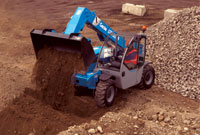
Small telehandlers are popular rental items. Compared to the spectrum of compact equipment (from skid steers to mini excavators), they are not the cheapest piece of machinery (ranging in price from $50,000 to $70,000). But the time-honored adage “You get what you pay for” certainly applies, as compacts boast high reach, spacious and comfortable cabs, fast travel speeds, tool-carrying capabilities, three steering modes and accessibility into confined and even indoor jobsites.
“Compact telehandlers fit nicely with price and applications in between our largest skid steer loaders and smallest compact wheel loaders,” says Scott Cooper, marketing manager for Caterpillar telehandlers. “Our largest customer base will be the Cat Rental Stores where we estimate approximately 60 percent of our shipments will go.”
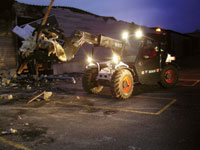
“I think North America was a little slow to recognize the benefits of compact telehandlers, both at the manufacturer and dealer level, and at the end-user level as well,” explains Kirk Dilly, product and training specialist for Gehl (which entered the telehandler market in 1987). “As telehandlers have steadily replaced ladders and scaffolding on jobsites, many contractors are realizing that they don’t need a full-size forklift for their applications. Warehouses and storage yards are just now realizing the advantages of a machine with a telescopic boom compared to straight-mast forklifts. Also, farms are getting larger and farmers are outgrowing their existing machinery. They’re replacing traditional loaders with more specialized compact telehandlers that can lift just as much, but higher.”
Implements of Versatility
In America, the bigger-is-better maxim is a common motto in the world of equipment. For decades, large pick-and-place telehandlers (with three- and four-stage booms, going up to 50 ft plus) dominated the North American construction, bridge and masonry industries. Names like JLG, Gradall, Lull and SkyTrak could be found on big jobsites, lifting large pallets of construction materials into aerial work environments.
Compact telehandlers are designed differently than their larger pick-and-place brethren. Generally, maneuverability in tight spaces is a requirement of compact telehandlers. A compact telehandler is oftentimes more adept in ground-engaging applications than a full-size unit. The third boom section in a full-size telehandler is generally considered the “weak point” of the machine if it is used to perform jobs other than pallet work. This third boom section (the inner-most section) is extended by a chain rather than by a hydraulic cylinder, thereby making it the section most vulnerable to damage if it’s stressed by use in ground-engaging applications, using a bucket, broom or auger. Compact telehandlers have only two boom sections, both powered by hydraulic cylinders. This adds to the rigidity of a compact telehandler and its boom.
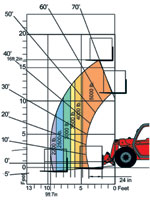
Compact telehandlers also offer unique characteristics when compared to competitive compact machinery — in both agriculture and construction applications.
“In compact telehandlers, consumers see a machine that can do more than traditional skid loaders and wheel loaders,” says John Rau, Gehl product and training specialist. “In the agriculture industry, mixer feeder wagons are getting larger, to the point that only a compact telehandler can load them. Smaller construction contractors need a versatile machine that can fit all their needs without having to hire someone to transport it.”
“Compact telehandlers have the reach advantage over skid steer loaders,” says Brian Boeckman, product manager of North American telehanders for JLG. “A few examples of when this feature comes in handy are when loading and unloading trucks, placing loads and backfilling. As the price points for large skid steers and compact telehandlers converge, the reach of a telehandler becomes even more attractive.”
Compact telehandlers are engineered similar to skid steers and wheel loaders in their ability to run attachments, which extends their versatility beyond load-and-place jobs (although that is still a popular application). Most manufacturers today allow their compacts to use some skid steer attachments (along with telehandler-specific implements), understanding the lift capacity and hydraulic flow of telehandlers and skid steers are different. Consult your dealer before adding skid steer attachments; some recommend not using them.
“Don’t limit the performance of a compact telehandler or create safety problems by using forks or buckets from a skid loader on a telehandler,” says Ford. “The load ratings of skid steers are nowhere near that of a compact telehandler.”
While some manufacturers market their machines with skid steer attachments. Bobcat recently introduced its smallest compact telehandler, the V417 VersaHandler. The V417 comes standard with a skid steer attachment mounting system. “Most owners of telehandlers are also owners of skid steer loaders,” says Greg Rostberg, marketing manager at Bobcat. “A contractor can maximize the versatility of his attachments by using 20 different attachments on the V417 that are also approved for use on large frame skid steer loaders.”
Yet it may not be practical to put your telehandler on cleanup duty with your skid’s angle broom if the telehandler would be better used removing leftover debris from a second story building. Of course, if you wanted to throw a broom onto a telehandler, its auxiliary hydraulics wouldn’t have a problem handling the attachment. Generally, compact telehandlers offer a gallons per minute (gpm) flow range of around 22 gpm.
Other popular implements include: industrial grapple buckets, which clamp down to grab hard-to-handle loads for easy, secure transportation; heavy-duty multi-purpose buckets, equipped with a bolt-on cutting edge for heavy-duty material transfer applications; truss booms, used for overhead lifting as they provide extra reach (up to 6 ft) to lift framing materials over obstacles; fork carriages, which shift from side-to-side or rotate to give the operator precise control of a load for pick-and-place applications; augers, an ideal tool for drilling holes for posts, piers, poles and trees in all kinds of soil conditions; and brooms, used to sweep driveways, sidewalks, parking lots, loading docks, warehouses and quick snow work.
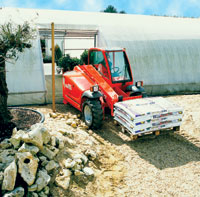
Creatures of Comfort and Precision
Machines must roll, and when it comes to efficient mobility, small telehandlers have a variety of specified steering modes for quick, maneuverable and precise jobsite work and travel. Most manufacturers offer three different steering modes as standard equipment on their telehandlers — two-wheel, four-wheel and crab steer. Two- and four-wheel steering are fairly self explanatory: two-wheel is mainly for traveling at high speeds over long distances like traversing the jobsite and the four-wheel steer is best used for tighter turning radii and maneuverability on difficult terrain. Crab steer enables both the front and rear wheels to shift 45 degrees left or right, allowing the machine to slide left or right for final placement tweaking.
“Compact telehandlers are used where skid steer loaders may disrupt new sod for example,” says Cooper. “The compacts can move without scraping the tires and with three modes of steering can maneuver around the jobsite very effectively. They can also unload trucks from one side in nursery yards — sod, mulch pallets, etc.”
Driving a telehandler is similar to driving a car, although using a telescoping boom in tight spots is not as easy as parallel parking. In fact, OSHA requires operator certification, except in agricultural applications. Operators are certified after attending and passing an operator training and safety course. There are several things operators need to be trained on, including: 1) the forklift operator’s manual; 2) hands-on training through a dealer or a private training institute; and 3) a full understanding of the load charts (“Lifting with a 19-ft machine with a rated capacity of 5,500 lbs does not mean it will lift that load throughout the boom’s full range of motion,” notes Rau).
The control pattern consists of a steering wheel, pedals and joystick to operate the boom. The cab environment itself is one of the more spacious and comfortable work areas in small equipment. While a simple ROPS cage might be the minimalist’s choice for an inexpensive machine, those who crave creature comforts can go with a fully-enclosed, quiet cab with a standard windshield washer, as well as a heater and defroster for cold climates. The left and rear windows can open for ventilation and air conditioning is also available as an option. Adjustable suspension seats, arm rests, tilt steering, cup holders and even satellite radio are available for telescoping enthusiasts.
“I say the imports including the compact [telehandlers] are the Ferrari performance units. The U.S. lift-and-place units are the work trucks,” says Ford. “Both can do their respective jobs. The compact imports do both lifting and multipurpose work with more style and comfort.”
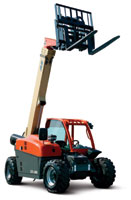
In January 2006, Caterpillar Inc. and JLG Industries Inc., a subsidiary of Oshkosh Corp., signed a 20-year strategic alliance agreement for JLG to design and produce a Cat telehandler product line for Caterpillar dealers, including their compact lines. The alliance has brought increased attention to the industry, while the companies’ super compact telehandlers manufactured in Shippensburg, Pa., make it one of the few companies to say it’s made in America.
Overall, the North American market reached sales numbers above 2,000 units last year. With increased interest and added competition, most companies see compact telehandlers continuing to grow in popularity.
“Telehandlers continue to find new applications in the marketplace, which will continue to fuel growth,” says Boeckman. “The variety of applications on a jobsite requires a very versatile machine. For example, these machines are becoming increasingly popular with landscapers and nurseries. This size of machine continues to be one of the fastest growing market segments in telehandlers.”
Keith Gribbins is managing editor of Compact Equipment, based in Peninsula, Ohio.
|

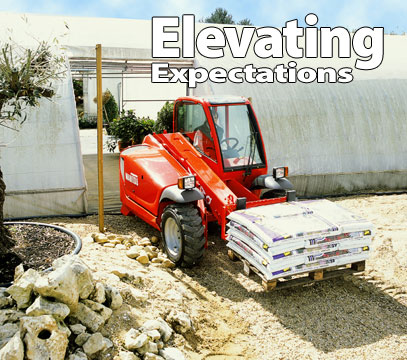
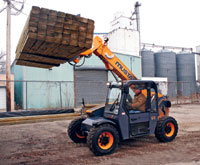 Heavy Lifting
Heavy Lifting
Comments are closed here.